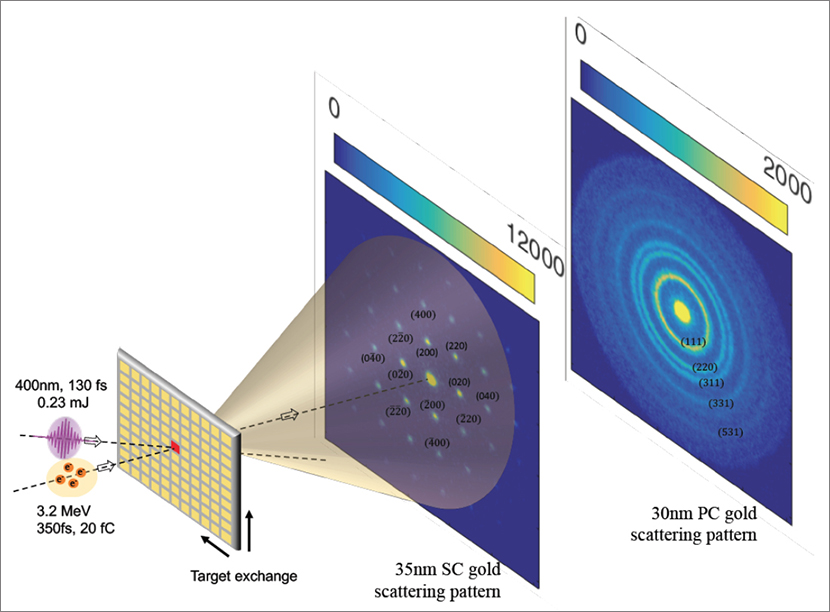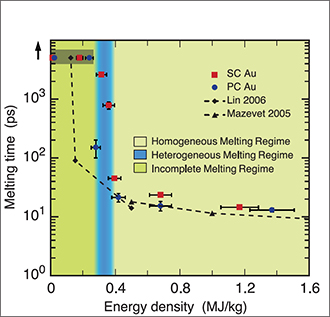-

-
Schematic of the experiment. SC is single crystalline, and PC is polycrystalline.
-
Understanding the fast melting of metals is important for welding and micromachining in many applications, including the engineering of fusion power reactors. However, melting happens so quickly that it has historically only been probed on the atomic scale through simulations. Molecular dynamics simulations of gold films have predicted the existence of distinct melting regimes that have been excited by ultrafast lasers at different energy densities, but experimental data on the phenomenon has not been recorded. In a study published in Science, an international team that included Los Alamos National Laboratory researchers performed ultrafast electron diffraction experiments on laser-pulsed gold films.
The researchers used a high-speed electron camera at SLAC National Accelerator Laboratory to make the first visualizations of the ultrafast melting of gold on the atomic length scale. The camera provided time-resolved electron diffraction with MeV electrons, enabling measurements with extremely high signal-to-noise ratios that resulted in detailed maps of melting gold. The team determined the ion and electron temperature evolution and found superheated conditions.
The data showed that gold melting happens through two distinct regimes while the bonding behavior changes in unexpected ways. For energy densities approaching the irreversible melting regime, the research team observed heterogeneous melting on time scales of 100–1000 ps. This transitioned to homogeneous melting that occurred catastrophically within 10–20 ps at higher energy densities. At intermediate energy densities, the team showed evidence for both solid and liquid coexisting heterogeneously. This was the first observation of heterogeneous melting. The observation enabled direct comparison with molecular dynamics simulations and revealed the sensitivity to nucleation seeds for melting. Watch the movies here.
The results provide critical information to test and improve the kinetic theories of melting and help advance the material processing related to solid-liquid phase transition to atomic-level precision. The discovery also reveals missing physical phenomena that should be included in high-energy melting models. The observation of heterogeneous coexistence reveals a new method for addressing important questions related to the determination of nucleation seeds for melting. This will provide critical information to test and improve the kinetic theories of melting and advance the material processing related to solid-liquid phase transition to atomic-level precision. The knowledge may aid development of inertial confinement fusion experiments and other applications that require materials to endure extreme conditions for long periods of time.
Reference: “Heterogeneous to Homogeneous Melting Transition Visualized with Ultrafast Electron Diffraction,” Science 360, 1451 (2018); doi: 10.1126/science.aar2058. Authors: M. Z. Mo, Z. Chen, R. K. Li, and M. Dunning (SLAC National Accelerator Laboratory); B. Witte (SLAC and University of Rostock in Germany); J. K. Baldwin (Center for Integrated Nanotechnologies, MPA-CINT); L. Fletcher and J. Kim (SLAC); A. Ng (University of British Columbia in Canada); R. Redmer (University of Rostock in Germany); A. H. Reid (SLAC); P. Shekhar (University of Alberta in Canada); X. Z. Shen (SLAC); M. Shen (University of Alberta in Canada); K. Sokolowski-Tinten (University of Duisburg-Essen in Germany); Y. Y. Tsui (University of Alberta in Canada); Y. Q. Wang (Materials Science in Radiation and Dynamics Extremes, MST-8); Q. Zheng, X. J. Wang, and S. H. Glenzer (SLAC).
The Department of Energy, the DOE Fusion Energy Sciences Program, and the DOE Basic Energy Sciences’ Accelerator and Detector program funded the Los Alamos portion of the work. Lab researchers synthesized the samples in an ultra-high vacuum electron beam evaporation system located at the Center for Integrated Nanotechnologies (CINT), a DOE Office of Basic Energy Sciences user facility jointly operated by Sandia National Laboratories and Los Alamos National Laboratory. The work supports the Laboratory’s Nuclear Deterrence and Energy Security mission areas and its Materials for the Future science pillar. Technical contact: Kevin Baldwin
-

Figure. Energy density dependence of ultrafast laser–induced melting mechanisms in gold. The measured melting time of SC (single crystalline) gold and PC (polycrystalline) gold are compared with two-temperature modeling coupled with molecular dynamics (TTM-MD) simulations by Lin and Mazevet.
| Period | Sep 26 2018 |
|---|
Media coverage
Media coverage
Title Gold melting at the atomic scale reveals first observation of heterogeneous melting Date 09/26/18 Persons Jon Kevin Scott Baldwin, Yongqiang Wang,
Media Type
- STE Highlight
Keywords
- LALP 18-001
STE Mission
- Energy Security
- Nuclear Deterrence
STE Pillar
- Materials for the Future